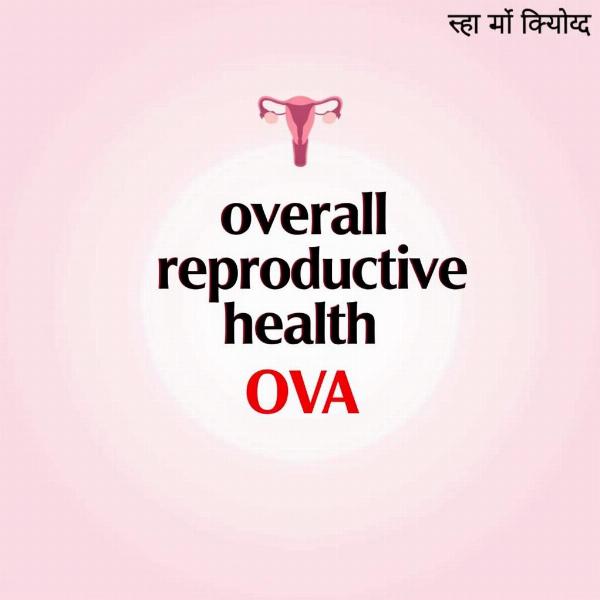Understanding the meaning of “ova” in Hindi is crucial for anyone navigating medical or biological texts. While the direct Hindi translation is often “अंडाणु” (andaanu), simply knowing this equivalent isn’t enough. This article explores the various nuances of “ova,” its biological significance, related terms, and its usage in different contexts. We’ll delve into the intricacies of this term to provide a comprehensive understanding beyond a simple dictionary definition.
Understanding the Biological Significance of Ova
Ova, the plural of ovum, refers to the female reproductive cells, also known as egg cells. These cells are produced in the ovaries and are essential for reproduction. In Hindi, the singular form, “ovum,” can be translated as “अंडाणु” (andaanu) or sometimes “बीजांड” (beejaand). Understanding the role of ova in the menstrual cycle, fertilization, and embryonic development is key to grasping the full meaning of the term. The process by which ova mature and are released is called ovulation, referred to as “अंडोत्सर्ग” (andotsarg) in Hindi.
Related Terms and Their Hindi Equivalents
Beyond “ova,” several related terms are frequently encountered in reproductive biology. Learning their Hindi equivalents can enhance comprehension. For instance, “ovaries,” where ova are produced, is translated as “अंडाशय” (andaashay). Similarly, the “fallopian tubes,” through which ova travel, are known as “डिंबवाहिनी” (dimbavahini). Knowing these associated terms offers a more holistic understanding of the reproductive system and the context in which “ova” is used. Other related terms include “zygote” (युग्मनज – yugmanj), the cell formed after fertilization, and “embryo” (भ्रूण – bhrun), the early stage of development after fertilization.
Ova in Different Contexts
The term “ova” isn’t restricted to purely biological discussions. It can appear in various contexts, from medical reports to educational materials. Understanding the specific usage is essential for accurate interpretation. For example, in fertility treatments like in-vitro fertilization (IVF), discussions about ova retrieval and fertilization are common. The Hindi term for IVF is “पात्रे निषेचन” (paatre nisechan). Similarly, discussions about ova donation and egg freezing also utilize the term “ova.”
Common Misconceptions about Ova
Several misconceptions surround the term “ova.” Some people confuse it with the entire egg, including the yolk and egg white. However, “ova” refers specifically to the reproductive cell within the egg. Clarifying these misconceptions is essential for accurate understanding. Another common misconception is the idea that women are born with a limited number of ova and continuously lose them throughout their lives. While the number of immature ova does decrease with age, the actual number of ova a woman has at birth is much higher than the number that will eventually mature and be released.
Why is Knowing the Hindi Meaning of Ova Important?
Knowing the Hindi meaning of “ova,” along with related terminology, is crucial for effective communication about reproductive health in Hindi-speaking communities. It allows individuals to access accurate information, participate in informed discussions, and make informed decisions about their reproductive health.
 Ova and Reproductive Health (Hindi)
Ova and Reproductive Health (Hindi)
Conclusion
Understanding “ova meaning in hindi” goes beyond a simple translation. It requires comprehending the biological significance of ova, related terms, and the context in which the term is used. This article has provided a comprehensive overview, clarifying common misconceptions and highlighting the importance of knowing the accurate Hindi terminology for effective communication about reproductive health.
FAQ
-
What is the most common Hindi word for “ova”? The most common Hindi word for “ova” is “अंडाणु” (andaanu).
-
What is the Hindi word for “ovulation”? The Hindi word for “ovulation” is “अंडोत्सर्ग” (andotsarg).
-
What is the difference between “ovum” and “ova”? “Ovum” is singular, referring to a single egg cell, while “ova” is the plural form.
-
Why is it important to know the Hindi terms related to reproduction? Knowing these terms facilitates clear communication about reproductive health in Hindi-speaking communities.
-
Where are ova produced? Ova are produced in the ovaries (अंडाशय – andaashay).
-
What happens to the ova after ovulation? After ovulation, the ova travel through the fallopian tubes (डिंबवाहिनी – dimbavahini).
-
What is the Hindi term for IVF? The Hindi term for IVF is “पात्रे निषेचन” (paatre nisechan).
Meaning-Hindi.in is your trusted partner for accurate and culturally sensitive Hindi translations. We specialize in various translation services, including business and commercial documents, legal and certified translations, technical manuals, website localization, educational and academic materials, and express translation services. Our expertise ensures precise and reliable translations for diverse needs. Contact us today for all your Hindi translation requirements! Email: [email protected], Phone: +91 11-4502-7584. Meaning-Hindi.in offers high-quality translation services tailored to your specific needs.